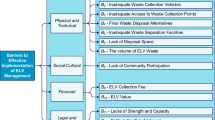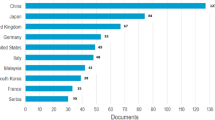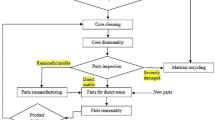Abstract
End-of-life vehicles (ELV) management is essential for sustainable development and waste minimization. However, the ELV recycling companies are facing supply and demand uncertainties in the product recovery of ELV. This study aims to identify the critical enablers and inhibitors for economic sustainability in Malaysia’s supply and demand of ELV. The study adopted a qualitative interview approach in six ELV-related case companies. A Strengths, Weaknesses, Opportunities, and Threats (SWOT) analysis was performed to assess the identified enablers (strengths and opportunities) and inhibitors (weaknesses and threats). The common strengths presented are the quality of cores (used parts) received and the strategic location of the case companies to optimize the reverse logistic network. The highlighted weaknesses are lack of established standard operating procedures, low employee specialization skills, and poor adoption of Industry 4.0 enabling technologies. The identified opportunity includes specific market demand from targeted customers, while the most prevalent threats are supply uncertainty in quantities of cores, no ELV policy in Malaysia, an inadequate subsidy system, customer misconceptions, and a market acceptance barrier for ELV products. The case companies and relevant stakeholders can formulate appropriate business strategies and policy frameworks to improve economic sustainability for optimizing the value chain of ELV in Malaysia.






Similar content being viewed by others
Abbreviations
- ELV:
-
End-of-life vehicles
- SWOT:
-
Strengths, Weaknesses, Opportunities, and Threats
- 6R:
-
Reduce, Reuse, Remanufacture, Recycle, Recover, and Redesign
- SM:
-
Sustainable manufacturing
- TIV:
-
Total Industry Volume
- RTD:
-
Road Transport Department
- NAP:
-
National Automotive Policy
- ACR:
-
Automotive components remanufacturing
- OEM:
-
Original equipment manufacturers
- CE:
-
Circular economy
- 4R2S:
-
Reuse, Recycle, Remanufacturing, Repair, Service, and Spare Parts
- EOL:
-
End-of-life
- MAARA:
-
Malaysia Automotive Recyclers Association
- AATF:
-
Authorized automotive treatment facility
- SOP:
-
Standard operating procedure
- RQF:
-
Remanufacturing Quality Factors
- AM:
-
Additive manufacturing
- IoT:
-
Internet of Things
- AP:
-
Approval Permit
- SMEs:
-
Small and medium-sized enterprizes
References
Kuşakcı AO, Ayvaz B, Cin E, Aydın N (2019) Optimization of reverse logistics network of end of life vehicles under fuzzy supply: a case study for Istanbul metropolitan area. J Clean Prod 215:1036–1051
Numfor SA, Omosa GB, Zhang Z, Matsubae K (2021) A review of challenges and opportunities for end-of-life vehicle recycling in developing countries and emerging economies: a SWOT analysis. Sustainability 13:4918
Golinska-Dawson P, Kosacka M, Nowak A (2015) Automotive parts remanufacturing—experience of Polish small companies. Chiang Mai Univ J Nat Sci 14:415–430
Wong YC, Al-Obaidi KM, Mahyuddin N (2018) Recycling of end-of-life vehicles (ELVs) for building products: concept of processing framework from automotive to construction industries in Malaysia. J Clean Prod 190:285–302
Ali HM, Simic V, Sitinjak C, Hassim JZ, Said MHM, Khalid RM, Kaka GE, Ismail R (2023) Exploring public perceptions and disposal procedures in the development of a comprehensive end-of-life vehicle regulation in Malaysia: a pilot study. Sustainability 15:4786
Karagoz S, Aydin N, Simic V (2020) End-of-life vehicle management: a comprehensive review. J Mater Cycles Waste Manag 22:416–442
Kafuku JM, Saman MZM, Yusof SMD, Sharif S, Zakuan N (2015) Investment decision issues from remanufacturing system perspective: literature review and further research. Procedia CIRP 26:589–594
Ravi V, Shankar R (2017) An ISM-based approach analyzing interactions among variables of reverse logistics in automobile industries. J Model Manag 12:36–52
Yang S, Raghavendra MRA, Kaminski J, Pepin H (2018) Opportunities for industry 4.0 to support remanufacturing. Appl Sci. https://doi.org/10.3390/app8071177
Merkisz-Guranowska A (2020) A comparative study on end-of-life vehicles network design. Arch Transp 54:107–123
Pallaro E, Subramanian N, Abdulrahman MD, Liu C (2015) Sustainable production and consumption in the automotive sector: integrated review framework and research directions. Sustain Prod Consum 4:47–61
Bernama (2022) Malaysia to implement end-of-life vehicle management policy by 2025. New Straits Times 12 Aug 2022
Malaysian Automotive Association (MAA) (2023) MAA press statement: record sales of new motor vehicles: TIV surpassed 700,000 unit mark. p 1–10
Raja Mamat TNA, Mat Saman MZ, Sharif S, Simic V (2016) Key success factors in establishing end-of-life vehicle management system: a primer for Malaysia. J Clean Prod 135:1289–1297
Azmi M, Mat Saman MZ, Sharif S (2013) Proposed framework for end-of-life vehicle recycling system implementation in Malaysia. In: Proceedings of the 11th global conference on sustainable manufacturing—innovative solutions, Germany, 23–25 Sept, p 187–193
Ali HM, Sitinjak C, Md Said MH, Hassim JZ, Ismail R, Simic V (2023) Model predicting social acceptance behavior to implement ELV policy: exploring the role of knowledge toward ELV policy on social acceptance in Malaysia. Front Public Health. https://doi.org/10.3389/fpubh.2022.1093732
Khan KMA, Said MFM, Jamaludin KR, Amiruddin I, Mohd A (2021) End of life vehicle (ELV) Management ecosystems in Malaysia. J Soc Automot Eng Malays 5:150–163
Chakraborty K, Mondal S, Mukherjee K (2019) Critical analysis of enablers and barriers in extension of useful life of automotive products through remanufacturing. J Clean Prod 227:1117–1135
Tian G, Zhang H, Feng Y, Jia H, Zhang C, Jiang Z, Li Z, Li P (2017) Operation patterns analysis of automotive components remanufacturing industry development in China. J Clean Prod 164:1363–1375
Chaowanapong J, Jongwanich J, Ijomah W (2018) The determinants of remanufacturing practices in developing countries: evidence from Thai industries. J Clean Prod 170:369–378
Goodall P, Rosamond E, Harding J (2014) A review of the state of the art in tools and techniques used to evaluate remanufacturing feasibility. J Clean Prod 81:1–15
Mohamad-Ali N, Raja Ghazilla RA, Abdul-Rashid SH, Ahmad-Yazid A (2019) Aftermarket survey on end-of-life vehicle recovery in Malaysia: Key findings. J Clean Prod 211:468–480
Wang L, Chen M (2013) End-of-life vehicle dismantling and recycling enterprises: developing directions in China. J Clean Prod 65:1015–1020
Mohamed N, Mat Saman MZ, Sharif S, Hamzah HS (2018) Strategic factors on interpreting remanufacturing quality-certifying framework to address warranty aftermarket for Malaysian industry. IOP Conf Ser Mater Sci Eng. https://doi.org/10.1088/1757-899X/328/1/012033
Tian G, Chu J, Hu H, Li H (2014) Technology innovation system and its integrated structure for automotive components remanufacturing industry development in China. J Clean Prod 85:419–432
Zhang X, Tang Y, Zhang H, Jiang Z, Cai W (2021) Remanufacturability evaluation of end-of-life products considering technology, economy and environment: a review. Sci Total Environ 764:142922
Yusop NM, Wahab DA, Saibani N (2016) Realising the automotive remanufacturing roadmap in Malaysia: challenges and the way forward. J Clean Prod 112:1910–1919
Matsumoto M, Yang S, Martinsen K, Kainuma Y (2016) Trends and research challenges in remanufacturing. Int J Precis Eng Manuf Green Technol 3:129–142
Shao J, Huang S, Lemus-Aguilar I, Ünal E (2020) Circular business models generation for automobile remanufacturing industry in China: barriers and opportunities. J Manuf Technol Manag 31:542–571
Zhou F, Lim MK, He Y, Lin Y, Chen S (2019) End-of-life vehicle (ELV) recycling management: improving performance using an ISM approach. J Clean Prod 228:231–243
Abdulrahman MDA, Subramanian N, Liu C, Shu C (2015) Viability of remanufacturing practice: a strategic decision making framework for Chinese auto-parts companies. J Clean Prod 105:311–323
Wei S, Cheng D, Sundin E, Tang O (2015) Motives and barriers of the remanufacturing industry in China. J Clean Prod 94:340–351
Yu Z, Tianshan M, Khan SAR (2020) Investigating the effect of government subsidies on end-of-life vehicle recycling. Waste Manag Res 39:860–870
Wan Z, Liu J, Zhang J (2020) Nonlinear optimization to management problems of end-of-life vehicles with environmental protection awareness and damaged/aging degrees. J Ind Manag Optim 16:2117–2139
Gan J, Luo L (2017) Using DEMATEL and intuitionistic fuzzy sets to identify critical factors influencing the recycling rate of end-of-life vehicles in China. Sustain 9:1–22
Mohan TVK, Amit RK (2020) Dismantlers’ dilemma in end-of-life vehicle recycling markets: a system dynamics model. Ann Oper Res 290:591–619
Yi S, Lee H (2021) Economic analysis to promote the resource circulation of end-of-life vehicles in Korea. Waste Manag 120:659–666
Chen Z, Chen D, Wang T, Hu S (2015) Policies on end-of-life passenger cars in China: dynamic modeling and cost-benefit analysis. J Clean Prod 108:1140–1148
Gorji MA, Jamali MB, Iranpoor M (2021) A game-theoretic approach for decision analysis in end-of-life vehicle reverse supply chain regarding government subsidy. Waste Manag 120:734–747
Wang Y, Chang X, Chen Z, Zhong Y, Fan T (2014) Impact of subsidy policies on recycling and remanufacturing using system dynamics methodology: a case of auto parts in China. J Clean Prod 74:161–171
Pisitsankkhakarn R, Vassanadumrongdee S (2020) Enhancing purchase intention in circular economy: an empirical evidence of remanufactured automotive product in Thailand. Resour Conserv Recycl 156:104702
Zailani S, Govindan K, Shaharudin MR, Kuan EEL (2017) Barriers to product return management in automotive manufacturing firms in Malaysia. J Clean Prod 141:22–40
Govindan K, Madan Shankar K, Kannan D (2016) Application of fuzzy analytic network process for barrier evaluation in automotive parts remanufacturing towards cleaner production—a study in an Indian scenario. J Clean Prod 114:199–213
Mathiyazhagan K, Sengupta S, Poovazhagan L (2018) A decision making trial and evaluation laboratory approach to analyse the challenges to environmentally sustainable manufacturing in Indian automobile industry. Sustain Prod Consum 16:58–67
Pan Y, Li H (2016) Sustainability evaluation of end-of-life vehicle recycling based on emergy analysis: a case study of an end-of-life vehicle recycling enterprise in China. J Clean Prod 131:219–227
Agrawal R, Wankhede VA, Kumar A, Luthra S (2021) Analysing the roadblocks of circular economy adoption in the automobile sector: reducing waste and environmental perspectives. Bus Strateg Environ 30:1051–1066
Chaabane A, Montecinos J, Ouhimmou M, Khabou A (2021) Vehicle routing problem for reverse logistics of end-of-life vehicles (ELVs). Waste Manag 120:209–220
Wang W, Mo DY, Wang Y, Tseng MM (2019) Assessing the cost structure of component reuse in a product family for remanufacturing. J Intell Manuf 30:575–587
Lin HT, Nakajima K, Yamasue E, Ishihara KN (2018) Recycling of end-of-life vehicles in small Islands: the case of Kinmen, Taiwan. Sustainability 10:1–14
Yu L, Chen M, Yang B (2019) Recycling policy and statistical model of end-of-life vehicles in China. Waste Manag Res 37:347–356
Yu Z, Tianshan M, Rehman SA, Sharif A, Janjua L (2020) Evolutionary game of end-of-life vehicle recycling groups under government regulation. Clean Technol Environ Policy. https://doi.org/10.1007/s10098-020-01898-9
Ngu HJ, Lee MD, Bin Osman MS (2020) Review on current challenges and future opportunities in Malaysia sustainable manufacturing: Remanufacturing industries. J Clean Prod 273:123071
Zhang T, Chu J, Wang X, Liu X, Cui P (2011) Development pattern and enhancing system of automotive components remanufacturing industry in China. Resour Conserv Recycl 55:613–622
Ropi NM, Hishamuddin H, Wahab DA (2020) Analysis of the supply chain disruption risks in the Malaysian automotive remanufacturing industry-a case study. Int J Integr Eng 12:1–11
Raja Mamat TNA, Mat Saman MZ, Sharif S, Simic V, Abd Wahab D (2018) Development of a performance evaluation tool for end-of-life vehicle management system implementation using the analytic hierarchy process. Waste Manag Res 36:1210–1222
Mohamad-Ali N, Ghazilla RAR, Abdul-Rashid SH, Sakundarini N, Ahmad-Yazid A, Stephenie L (2017) A system dynamics approach to develop a recovery model in the Malaysian automotive industry. IOP Conf Ser Mater Sci Eng. https://doi.org/10.1088/1757-899X/210/1/012068
Mohamad-Ali N, Ghazilla RAR, Abdul-Rashid SH, Sakundarini N, Ahmad-Yazid A, Stephenie L (2018) End-of-life vehicle recovery factors: Malaysian stakeholders’ views and future research needs. Sustain Dev 26:713–725
Priyono A (2015) A strategic operations framework for disassembly in remanufacturing. Diss Univ Strat, p 1–329
Kumar R (2011) Research Methodology—a step-by-step guide for beginners, 3rd edn. Sage, New Delhi
Harun Z, Wan Mustafa WMS, Abd Wahab D, Abu Mansor MR, Saibani N, Ismail R, Mohd Ali H, Hashim NA, Mohd Paisal SM (2021) An analysis of end-of-life vehicle policy implementation in Malaysia from the perspectives of laws and public perception. J Kejuruter 33:695–703
Beleya P, Veerappan G, Ding WJ, Tan J (2020) Challenges in attaining sustainable development goals in port Klang: Port management perspective. Int J Supply Chain Manag 9:349–355
Amelia L, Wahab DA, Che Haron CH, Muhamad N, Azhari CH (2009) Initiating automotive component reuse in Malaysia. J Clean Prod 17:1572–1579
Creswell JW (2014) Research design—qualitative, quantitative, and mixed methods approaches, 4th edn. Sage, Thousand Oaks
Sharma L, Pandey S (2020) Recovery of resources from end-of-life passenger cars in the informal sector in India. Sustain Prod Consum 24:1–11
Arora N, Bakshi SK, Bhattacharjya S (2019) Framework for sustainable management of end-of-life vehicles management in India. J Mater Cycles Waste Manag 21:79–97
Zhang H, Chen M (2013) Research on the recycling industry development model for typical exterior plastic components of end-of-life passenger vehicle based on the SWOT method. Waste Manag 33:2341–2353
Ayvaz B, Kusakci AO, Aydin N, Ertas E (2021) Designing reverse logistics network for end-of-life vehicles: a sustainability perspective in a fragile supply chain. Int J Ind Eng Theory Appl Pract 28:298–328
Kurilova-Palisaitiene J, Sundin E, Poksinska B (2018) Remanufacturing challenges and possible lean improvements. J Clean Prod 172:3225–3236
Sun Y, Wang YT, Chen C, Yu B (2018) Optimization of a regional distribution center location for parts of end-of-life vehicles. Simulation 94:577–591
Bhari B, Yano J, Sakai S-i (2021) Comparison of end-of-life vehicle material flows for reuse, material recycling, and energy recovery between Japan and the European Union. J Mater Cycles Waste Manag 23:644–663
Mohamed N, Mat Saman MZ, Safian S (2017) Quality assurance of remanufactured components of end-of-life vehicle: a literature review. Adv Sci Lett 23:4644–4648
Jamaluddin F, Saibani N, Maisarah S, Pisal M, Wahab DA, Hishamuddin H, Sajuri Z, Khalid R (2022) End-of-life vehicle management systems in major automotive production bases in Southeast Asia : a review. Sustainability 14:14317
MARii (2019) MS 4R2S Standards. Malaysia Automotive, Robot IoT Inst 10
Arnold M, Pohjalainen E, Steger S, Kaerger W, Welink J-H (2021) Economic viability of extracting high value metals from end of life vehicles. Sustainability 13:1902
Tian J, Chen M (2016) Assessing the economics of processing end-of-life vehicles through manual dismantling. Waste Manag 56:384–395
Centre for Remanufacturing and Reuse (2015) Remanufacturing in Malaysia an assessment of the current and future. APEC Rep 57
Yusop NM, Wahab DA, Saibani N (2012) Analysis of remanufacturing practices in the Malaysian automotive industry. J Teknol (Sci Eng) 59:77–80
Yusoh SSM, Wahab DA, Azman AH (2020) Analysis of automotive component design for reparation using additive manufacturing technology. Int J Integr Eng 12:20–26
Delpla V, Kenné J, Hof LA (2021) Circular manufacturing 4.0: towards internet of things embedded closed-loop supply chains. Int J Adv Manuf Technol 118:3241–3264
Bobba S, Tecchio P, Ardente F, Mathieux F, dos Santos FM, Pekar F (2020) Analysing the contribution of automotive remanufacturing to the circularity of materials. Procedia CIRP 90:67–72
Acknowledgements
The research has been carried out under Konsortium Kecemerlangan Penyelidikan [JPT(BKPI)1000/016/018/25(72)] provided by the Ministry of Higher Education of Malaysia (UTM Vot. No. R.J130000.7809.4L943). The authors also would like to express their gratitude towards the MAARA and the case companies for their dedicated support.
Funding
This study was supported by Ministry of Higher Education of Malaysia, UTM vot no. R.J130000.7809.4L943, Muhamad Zameri Mat Saman.
Author information
Authors and Affiliations
Corresponding author
Additional information
Publisher's Note
Springer Nature remains neutral with regard to jurisdictional claims in published maps and institutional affiliations.
Electronic supplementary material
Below is the link to the electronic supplementary material.
Rights and permissions
Springer Nature or its licensor (e.g. a society or other partner) holds exclusive rights to this article under a publishing agreement with the author(s) or other rightsholder(s); author self-archiving of the accepted manuscript version of this article is solely governed by the terms of such publishing agreement and applicable law.
About this article
Cite this article
Chong, J.Y., Mat Saman, M.Z. & Ngadiman, N.H.A. Critical enablers and inhibitors for economic sustainability in the supply and demand of end-of-life vehicles in Malaysia: a SWOT analysis. J Mater Cycles Waste Manag 25, 3048–3064 (2023). https://doi.org/10.1007/s10163-023-01738-0
Received:
Accepted:
Published:
Issue Date:
DOI: https://doi.org/10.1007/s10163-023-01738-0




